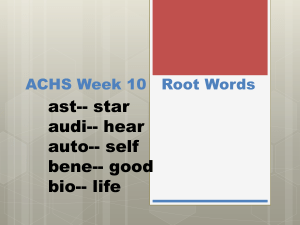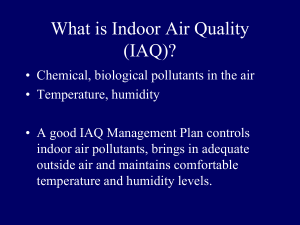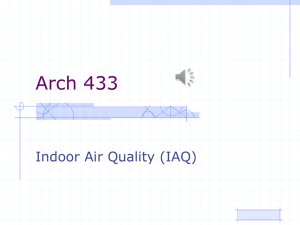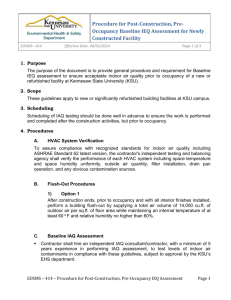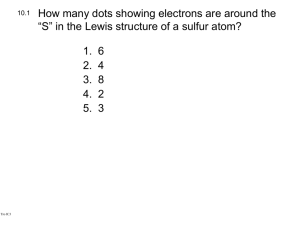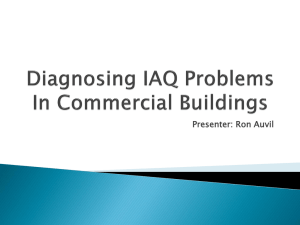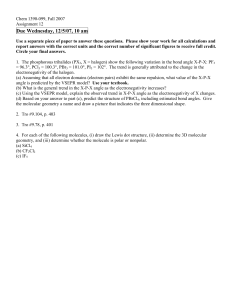You are given an aqueous solution that contains a Co 2+ salt. Based
advertisement
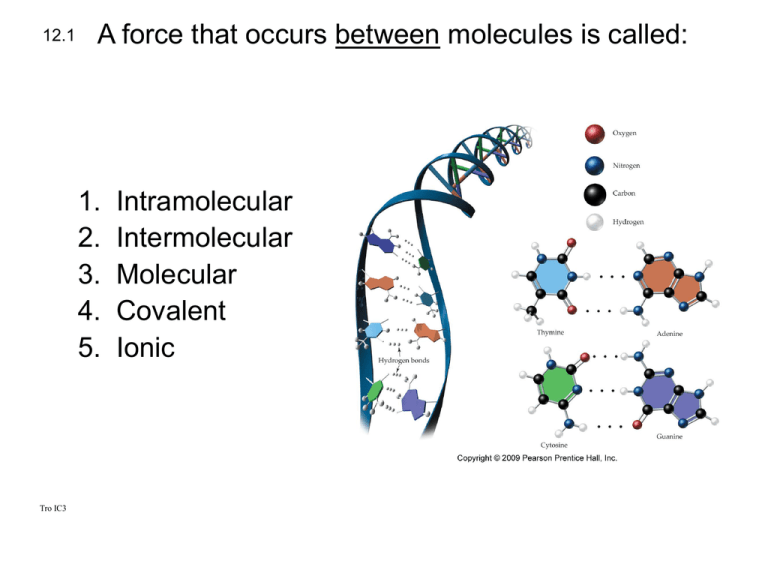
12.1 A force that occurs between molecules is called: 1. 2. 3. 4. 5. Tro IC3 Intramolecular Intermolecular Molecular Covalent Ionic 12.1 A force that occurs between molecules is called: 1. 2. 3. 4. 5. Tro IC3 Intramolecular Intermolecular Molecular Covalent Ionic 12.2 A force that occurs between atoms within a compound might be: 1. 2. 3. 4. 5. Tro IC3 Intramolecular Ionic Covalent All of the above Two of the above 12.2 A force that occurs between atoms within a compound might be: 1. 2. 3. 4. 5. Tro IC3 Intramolecular Ionic Covalent All of the above Two of the above 12.3 Which pure compound has the highest total intermolecular forces per molecule at 25 °C? 1. 2. 3. 4. 5. Tro IC3 Carbon dioxide Water Rubbing alcohol Table sugar Gasoline 12.3 Which pure compound has the highest total intermolecular forces per molecule at 25 °C? 1. 2. 3. 4. 5. Tro IC3 Carbon dioxide Water Rubbing alcohol Table sugar Gasoline 12.4 Which property describes a molecular liquid? 1. 2. 3. 4. 5. Tro IC3 The molecules are close together. The density is higher than its gas. It is not compressed easily. It assumes the shape of its container. All of the above 12.4 Which property describes a molecular liquid? 1. 2. 3. 4. 5. Tro IC3 The molecules are close together. The density is higher than its gas. It is not compressed easily. It assumes the shape of its container. All of the above 12.5 Which property best describes a molecular solid? 1. The solid has a lower density than its gas. 2. The solid has a lower average kinetic energy than its gas at the same temperature. 3. The solid is easy to compress. 4. The solid does not assume the shape of its container. 5. All of the above Tro IC3 12.5 Which property best describes a molecular solid? 1. The solid has a lower density than its gas. 2. The solid has a lower average kinetic energy than its gas at the same temperature. 3. The solid is easy to compress. 4. The solid does not assume the shape of its container. 5. All of the above Tro IC3 12.6 1. 2. 3. 4. Why doesn’t a paper clip sink when the clip is placed gently on water? It is less dense than water. It is more dense than water. The repulsive forces override the attractive forces. There are strong intermolecular forces between the water and the metal. 5. The molecules of water hold to each other and keep it from sinking. Tro IC3 12.6 1. 2. 3. 4. Why doesn’t a paper clip sink when the clip is placed gently on water? It is less dense than water. It is more dense than water. The repulsive forces override the attractive forces. There are strong intermolecular forces between the water and the metal. 5. The molecules of water hold to each other and keep it from sinking. Tro IC3 12.7 1. 2. 3. 4. 5. Tro IC3 Which of the following has the highest viscosity? Oxygen gas Pancake syrup Running water Liquid helium Rubbing alcohol 12.7 1. 2. 3. 4. 5. Tro IC3 Which of the following has the highest viscosity? Oxygen gas Pancake syrup Running water Liquid helium Rubbing alcohol 12.8 1. 2. 3. 4. 5. Tro IC3 The transformation from a liquid to a gas is called: Condensation Evaporation Sublimation Vaporization Two of the above 12.8 1. 2. 3. 4. 5. Tro IC3 The transformation from a liquid to a gas is called: Condensation Evaporation Sublimation Vaporization Two of the above 12.9 What happens to the kinetic energy of gaseous water molecules during condensation? 1. 2. 3. 4. 5. Tro IC3 It remains unchanged. It decreases. It increases. None of the above All of the above 12.9 What happens to the kinetic energy of gaseous water molecules during condensation? 1. 2. 3. 4. 5. Tro IC3 It remains unchanged. It decreases. It increases. None of the above All of the above 12.10 Which of the following is the most volatile? 1. 2. 3. 4. 5. Tro IC3 Gold Vegetable oil Water Motor oil Fingernail polish remover 12.10 Which of the following is the most volatile? 1. 2. 3. 4. 5. Tro IC3 Gold Vegetable oil Water Motor oil Fingernail polish remover 12.11 1. 2. 3. 4. 5. What is the relationship between the external pressure and the boiling point of a compound? The boiling point increases with increased pressure. The boiling point increases with decreased pressure. The boiling point decreases with increased pressure. The boiling point decreases with decreased pressure. Two of the above Tro IC3 12.11 1. 2. 3. 4. 5. What is the relationship between the external pressure and the boiling point of a compound? The boiling point increases with increased pressure. The boiling point increases with decreased pressure. The boiling point decreases with increased pressure. The boiling point decreases with decreased pressure. Two of the above Tro IC3 12.12 What is the gas found within a bubble of boiling water? 1. 2. 3. 4. 5. Tro IC3 Oxygen Water vapor Nothing Hydrogen Nitrogen 12.12 What is the gas found within a bubble of boiling water? 1. 2. 3. 4. 5. Tro IC3 Oxygen Water vapor Nothing Hydrogen Nitrogen 12.13 Which of the following processes are exothermic? 1. 2. 3. 4. 5. Tro IC3 Boiling Freezing Condensation Both 1 and 2 Both 2 and 3 12.13 Which of the following processes are exothermic? 1. 2. 3. 4. 5. Tro IC3 Boiling Freezing Condensation Both 1 and 2 Both 2 and 3 12.14 Which of the following contains the most thermal energy? 1. 2. 3. 4. 5. Tro IC3 5 grams of water at 100 °C 5 grams of water at 75 °C 5 grams of steam at 100 °C 5 grams of water at 0 °C 5 grams of ice at 0 °C 12.14 Which of the following contains the most thermal energy? 1. 2. 3. 4. 5. Tro IC3 5 grams of water at 100 °C 5 grams of water at 75 °C 5 grams of steam at 100 °C 5 grams of water at 0 °C 5 grams of ice at 0 °C 12.15 What is the quantity of energy required to boil 45.5 g of liquid water at 100 °C at sea level? The molar heat of vaporization of water is 40.6 kJ/mol. 1. 2. 3. 4. 5. Tro IC3 1.85 x 103 kJ 1.12 kJ 103 kJ 2.52 kJ 40.6 kJ 12.15 What is the quantity of energy required to boil 45.5 g of liquid water at 100 °C at sea level? The molar heat of vaporization of water is 40.6 kJ/mol. 1. 2. 3. 4. 5. Tro IC3 1.85 x 103 kJ 1.12 kJ 103 kJ 2.52 kJ 40.6 kJ 12.16 What is the energy required to melt 4.50 mol of ice at 0 °C? The molar heat of fusion of water is 6.02 kJ/mol. 1. 2. 3. 4. 5. Tro IC3 27.1 kJ 6.02 kJ 1.34 kJ 1.50 kJ 30.5 kJ 12.16 What is the energy required to melt 4.50 mol of ice at 0 °C? The molar heat of fusion of water is 6.02 kJ/mol. 1. 2. 3. 4. 5. Tro IC3 27.1 kJ 6.02 kJ 1.34 kJ 1.50 kJ 30.5 kJ 12.17 Which statement is most likely true concerning an ice/water mixture kept at 0 °C? 1. 2. 3. 4. 5. Tro IC3 The rate of freezing is faster. The rate of melting is faster. The ice will always melt. The water will always freeze. The rates of freezing and melting are equal. 12.17 Which statement is most likely true concerning an ice/water mixture kept at 0° C? 1. 2. 3. 4. 5. Tro IC3 The rate of freezing is faster. The rate of melting is faster. The ice will always melt. The water will always freeze. The rates of freezing and melting are equal. 12.18 Which type of intermolecular force is the strongest? 1. 2. 3. 4. 5. Tro IC3 Covalent Dipole–dipole Hydrogen bonding Ionic Dispersion 12.18 Which type of intermolecular force is the strongest? 1. 2. 3. 4. 5. Tro IC3 Covalent Dipole–dipole Hydrogen bonding Ionic Dispersion 12.19 1. 2. 3. 4. 5. Tro IC3 Which intermolecular force allows water to bead on a surface? Ionic Dipole–dipole Hydrogen bonding Dispersion Covalent 12.19 1. 2. 3. 4. 5. Tro IC3 Which intermolecular force allows water to bead on a surface? Ionic Dipole–dipole Hydrogen bonding Dispersion Covalent 12.20 Which of the following has the highest boiling point? 1. 2. 3. 4. 5. Tro IC3 CH3CH2CH3 CH3CH2NH2 CH3OCH3 CH4 CH3CH2OH 12.20 Which of the following has the highest boiling point? 1. 2. 3. 4. 5. Tro IC3 CH3CH2CH3 CH3CH2NH2 CH3OCH3 CH4 CH3CH2OH 12.21 Which of the following has the least solubility in water? 1. 2. 3. 4. 5. Tro IC3 CH3CH2CH3 CH3CH2NH2 CH3OCH3 H2O CH3CH2OH 12.21 Which of the following has the least solubility in water? 1. 2. 3. 4. 5. Tro IC3 CH3CH2CH3 CH3CH2NH2 CH3OCH3 H2O CH3CH2OH 12.22 What type of intermolecular force causes today’s Saran Wrap to stick to itself? 1. 2. 3. 4. 5. Tro IC3 Dipole–dipole Hydrogen bonding Dispersion Ionic Covalent 12.22 What type of intermolecular force causes today’s Saran Wrap to stick to itself? 1. 2. 3. 4. 5. Tro IC3 Dipole–dipole Hydrogen bonding Dispersion Ionic Covalent 12.23 Arrange the following in order of increasing melting point (lowest first): CO2, Si, H2O, and NaCl. 1. 2. 3. 4. 5. Tro IC3 NaCl, Si, CO2, H2O Si, NaCl, H2O, CO2 H2O, CO2, NaCl, Si CO2, H2O, NaCl, Si CO2, H2O, Si, NaCl 12.23 Arrange the following in order of increasing melting point (lowest first): CO2, Si, H2O, and NaCl. 1. 2. 3. 4. 5. Tro IC3 NaCl, Si, CO2, H2O Si, NaCl, H2O, CO2 H2O, CO2, NaCl, Si CO2, H2O, NaCl, Si CO2, H2O, Si, NaCl 12.24 What type of crystalline solid is formed by potassium iodide? 1. 2. 3. 4. 5. Tro IC3 Molecular Ionic Atomic Amorphous None of the above 12.24 What type of crystalline solid is formed by potassium iodide? 1. 2. 3. 4. 5. Tro IC3 Molecular Ionic Atomic Amorphous None of the above 12.25 1. 2. 3. 4. 5. Tro IC3 Which of the following is an example of an atomic solid? C6H12O6 HCl S8 NaCl None of the above 12.25 1. 2. 3. 4. 5. Tro IC3 Which of the following is an example of an atomic solid? C6H12O6 HCl S8 NaCl None of the above
